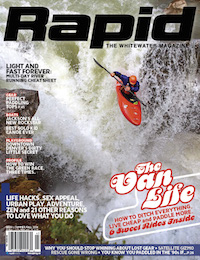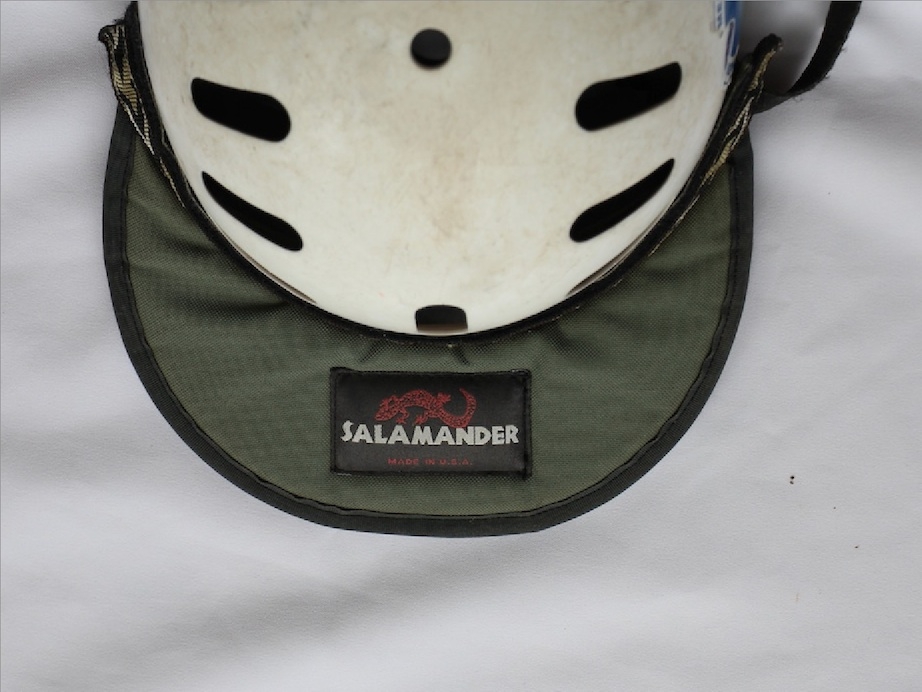In the days when playboats were more than eight feet long, when freestyle was called rodeo and pirouettes were a hot move, paddlers had a problem.
It was the early 90s, and the Pro-Tec and Wildwater helmets of the day worked well for protection but did little for sun protection.
People layered baseball caps under their helmets to add a brim, but the pressure of the hats’ buttons pressing into their skulls meant every paddling session ended with headaches.
Around the same time, Patrick Kruse sat in his Seal Beach, California, basement apartment trying to solve a dilemma of his own: how to launch his startup gear company into the world of whitewater and stand out against other manufacturers.
A paddler himself, Kruse had heard complaints about the baseball cap conundrum.
After a two-day flurry of cardboard and fabric cutting and pasting, he emerged with a design that would push his new business into the mainstream.
The Salamander brim was a hit.
For years, every Dagger Crossfire and Perception Pirouette contained a paddler whose helmet had a sticky Velcro strip and colorful, three-inch, foam-filled visor.
It came out in more and more colors and jungle and hibiscus patterns that would’ve made the Fresh Prince proud.
More than two decades later, the same brim comes with the same Salamander logo on the same 600-denier poly-cloth and Volara foam with Velcro-705 molded hooks, as when Kruse first designed it.
It remains on Salamander’s best seller list and is easily the company’s defining product.
In the late ‘90s though, helmet companies like Orosi started catching on—modern helmets emerged with built-in brims and started turning heads.
The Salamander does offer one advantage over built-in brims, says current owner, Shane Preston, who’s been with the company for six years. “If a kayaker is upside down, the bill will actually flip back rather than catch the water and yank your head back.”
Today, companies like Sweet Protection, WRSI, Shred Ready and Predator all make brimmed buckets of their own. But Salamander lives on.
The company still sells 2,500 visors every year, although for the most part, it’s not us buying them.
“To be 100 percent honest, it’s the horse industry—they love these things,” says Preston.
Salamander now sells 20 times more brims to its equestrian market than to whitewater paddlers. The visors fit on riding helmets just as well as they once did on whitewater helmets.
He’s also selling to bike and ski shops.
“For the hot kayakers, not too many kids are wearing them because they’re a little dorky looking,” Preston says. “But they work. You can’t deny that it gives you some nice protection.”
Salmander’s original visor designer Patrick Kruse now runs a company called Ruffwear selling performance dog gear in Oregon.
Three years ago on a hot summer day he was driving down Highway 395 towards Red Rock Canyon when a giant grin spread across his face. On the side of the road he saw a crew of 20 or so road workers, each with a bright red Salamander visor Velcroed to their hardhats.
 This article first appeared in the Summer/Fall 2014 issue of Rapid Magazine. Subscribe to Paddling Magazine’s print and digital editions, or browse the archives.
This article first appeared in the Summer/Fall 2014 issue of Rapid Magazine. Subscribe to Paddling Magazine’s print and digital editions, or browse the archives.




